|
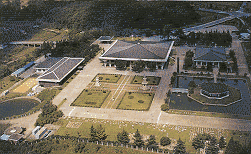
▲ Gyeongju National Museum
|
At
the Gyeongju National Museum, one can get a complete
view of the Silla Dynasty at a glance. In
an effort to restore the splendid
cultural heritage and spirit of arts, the
wishes of the citizens of Gyeongju were
realized with the opening of the museum in
Inwang-dong in 1975.
The museum contains 100,000 pieces of
valuable relics recovered in and
around Gyeongju. Among them, 2,500 items are always
on exhibit.
|
|
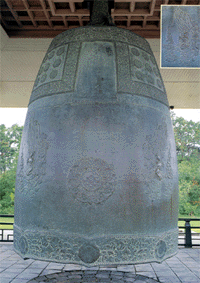
▲ The Divine Bell of King Seongdeok
|
This
bronze bell, called " The Divine Bell of
King Seongdeok" was cast in memory of King Seongdeok
and was completed during the reign of
King Hyegong.
Having very elegant and tense looks, together with
a crystal-clear and eloquent sound,
it is by far the best of its kind.
It was once said, "There is none greater
when it comes to bells; it is the all-time best
bell.”
|
|
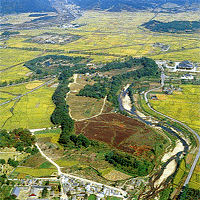
▲ Banwolseong Castle
|
In
the middle of Gyeongju City, just outside the
downtown area, is the Banwolseong Castle site, up
on a hill, in a crescent shape; it is one of Silla's
palatial ruins.
With the South River (Namcheon) to its front
and overlooking Namsan Castle in the
distance, Banwolseong Castle was, geographically,
a very important fortress.
Down
from Banwolseong, you can find Gyerim(Chicken
Forest), where the founder of the Kim clan,
Kim Al-ji, was said to have been born.
According to the story, King Talhae heard the
sound of a chicken in the forest, at that spot,
a gold box was found hanging from the
branch of a tree, with a white chicken
under it. A baby, Kim Al-ji, was found in
the box.
Near
Gyerim, there is the Cheomseongdae Observatory,
one of the oldest astronomical
observatories of its kind East Asia.
The observatory consists of 362 stones which correspond
to the days in a year and representing the number
of basic stars.
|
|
|
|
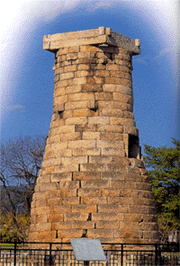
▲ Cheomseongdae Observatory
|
|
|
|
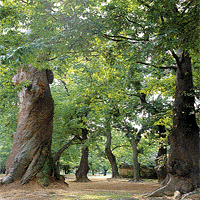
▲ Gyerim Forest
|
 |
 Daereungwon
Nodong and Noseo-dong Tumuli park
Daereungwon
Nodong and Noseo-dong Tumuli park |
 |
|
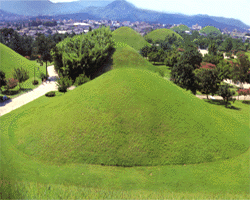
▲ Daereungwon
|
In
harmony with the people living in Gyeongju today,
the tombs recall the atmosphere of the ancient
capital of Silla.
Of particular note are the tombs near the center
of Gyeongju, which unite the Hwango-dong,
Hwangnam-dong, Nodong and Noseo-dong areas of the
city.
The tombs create a panoramic scene, in their clusters.
They were constructed during the early stages
of ancient Silla and have yielded many treasures,
including a gold crown.
|
|
|
|
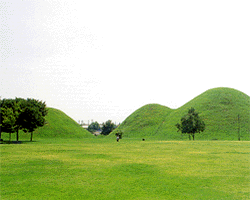
▲ Nodong and Noseo-dong Tumuli
park
|
|

▲ Wooden pagoda site
|
To
the east of Anapji Pond, is located the Hwangryongsa Temple
site, the largest one from the Silla Dynasty.
It was built over a long period of 93
years, through four kings, from
553 A.D.(in the 14th year of King Jinheung)
to 645 A .D.(in the 14th year of Queen Seondeok).
Originally intended as a royal palace, legend
has it that a yellow dragon appeared and
the place was rebuilt and renamed Hwangryongsa(Yellow
Dragon Temple).
Along with the legend of the guardian
dragon, it was considered a symbol of
protection for Silla against evil.
Among its treasures were a nine-story wooden
pagoda, Geumdong Buddha Triad, Geumdang mural
by Solgeo, and a huge bronze bell weighing 500,000
geun (one geun is about.6 kilograms).
Remaining, is a giant protective stone, to remind
people of the magnificent scale of that time.
|
|
|
|
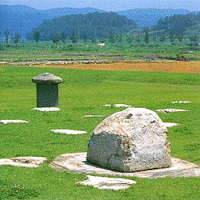
▲ Simchoseok
|
|
|
|
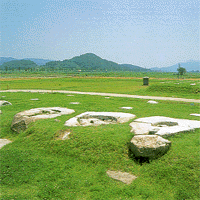
▲ Geumdang Site Jangryuksang pedestal
|
|
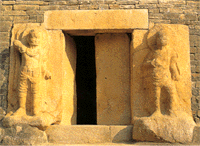
▲ Inwang Statue of Bunhwangsa Temple
|
Located
on the north side of Hwangryongsa Temple,
Bunhwangsa Temple was the home of many Silla monks,
such as Wonhyo and Jajang.
It was founded in 634 A
.D. (In the 3rd year of Queen Seondeok), and
the monk Jajang had served as chief monk there after
studying in Dang Dynasty China.
It is the very temple where Wonhyo wrote many books
and brought Buddhism to the common people.
The temple once housed a Cheonsudaebihwa painting
and Gwaneumbosal mural by Solgeo, but they were
lost after several invasions.
On the temple grounds, you can find a stone
pagoda built with rocks shaped like bricks
and the Hwajaengguksabi Monument in Wonhyo`s honor.
The well, called Samyongbyeoneojeong, remains
intact after more then a millenium and is
still in use.
Neungji Pagoda is in the neighborhood of Temple
Sacheonwangsa, Tomb of Queen Seondeok, Tomb
of King Sinmun.
The site of the pagoda is assumed to be the place
where King Munmu was cremated.
|
|
|
|
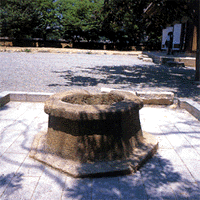
▲ Samyongbyeoneojeong Well
|
|
|
|
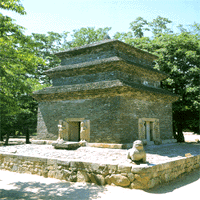
▲ Stone Pagoda of Bunhwangsa Temple
|
|
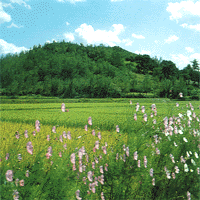
▲ Mt. Nangsan
|
Mt.
Nangsan has a long history, even though the hill
only 104 meters high.
Silla people never cut the trees on this hill,
as they believed mountain spirits would come
down.
This is also where Baekyeol, the great
composer of Silla, led a clean and destitute life
by getting away from the world outside.
Also, Choi Chi-won, a great writer, had his
home here.
Around Mt. Nangsan, are the royal tombs of
king Seondeok, Sinmun and Hyogong. Located
here is also the Neungji Pagoda where
King Munmu was cremated.
Many temple sites were scattered around as well.
|
|
|
|
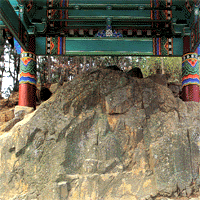
▲ Maaejijangsamjon Buddha Relief
|
|
|
|
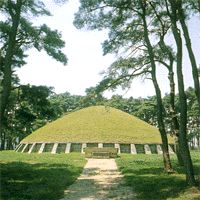
▲ Royal Tomb of King Sinmun
|
|